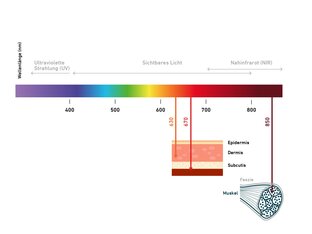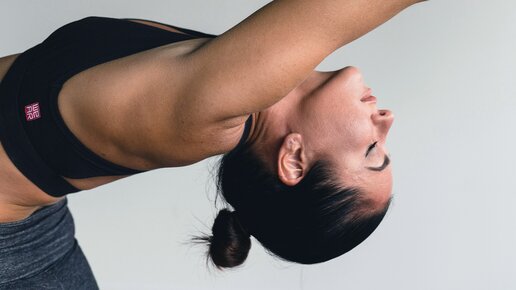Whether for regeneration after exercise, as a beauty booster or mood enhancer – red light therapy is everywhere. Athletes swear by red light cabins, influencers present themselves wearing futuristic LED masks, and many hope for anti-ageing miracles. In her practice, dermatologist Dr. Katharina Medek is asked daily: Does it really work? So it's time to explain the scientific facts:


What is red light therapy exactly?
Red light is a special form of light that lies within the visible range of the light spectrum – more precisely, at wavelengths between approximately 620 and 750 nanometres. So it is actually red light – perhaps that rings a bell? That's right: sunrise or sunset. It is precisely these warm, natural lighting conditions that are specifically imitated in red light applications. Red light primarily affects the upper layers of the skin and the underlying tissue.
Directly adjacent to visible red light is near-infrared light (NIR), which is invisible to the human eye but has a noticeable effect at deeper levels. Near-infrared light penetrates significantly deeper into the body than red light. This deeper effect makes it possible to reach deeper layers of muscle and tissue. Many modern applications combine both visible red light and near-infrared light. The result? Light therapy that starts on the surface and can work deep within the tissue.
In the context of red light application, the term LLLT often appears – the abbreviation for Low-Level Laser Therapy. This involves using low-energy light via special lasers or LEDs to stimulate regeneration processes in the body. In a red light cabin, the low-level laser is combined with red light and near-infrared light.
5 reasons why you should try red light treatment
Red light is more than just warm – it's a silent supporter for body and mind. We show you how versatile the effects of red light can be:
1. Reduce inflammation, boost the immune system
Red light can accompany anti-inflammatory processes and thus gently support your immune system. A little help when your body is working hard.
2. Well circulated – well supplied
The soothing warmth of red light can dilate blood vessels and stimulate blood circulation. This brings fresh energy to stressed areas and supports the natural supply of nutrients to your tissue.
3. Regeneration
Red light can support the body's own repair and renewal processes at the cellular level – whether after exercise, for muscle tension or simply as part of your daily skincare routine.
4. Collagen boost for your skin
Red light stimulates collagen production – a natural anti-ageing effect that supports your skin from within and can ensure a smoother, firmer complexion.
5. Heat that can relieve pain
Whether you have aching muscles or tense joints, red light can help relieve pain and help you move more freely again.
The effects and benefits of red light therapy on your body
Studies show that it can dilate blood vessels, thereby promoting blood circulation. This allows oxygen and nutrients to reach the areas of your body that need them most quickly. It sounds simple, but it is essential for regeneration and energy.
An exciting research approach is investigating the effect of red light on mitochondria – the cell components known as our internal ‘power plants’. Targeted light pulses could increase their activity and boost ATP production – the very form of energy that powers our cells. This can stimulate cell metabolism, support repair processes and reduce oxidative stress – all key factors for energy, vitality and good regeneration.
Rotlicht findet heute in vielen Bereichen Anwendung – besonders bekannt ist es aus der Muskelregeneration oder zur Linderung von Schmerzen und Entzündungen.
But people with chronic conditions such as rheumatism also report positive effects. And research is investigating possible supportive effects in neurodegenerative diseases (such as Alzheimer's), autoimmune diseases and diabetes.
Your inner balance also benefits: initial studies link red light with improved sleep quality and a more positive mood. A nice reminder that well-being doesn't have to be complicated – sometimes a few minutes of light is all it takes.
For anyone who wants to get more out of their training: An exciting addition for active people: in performance studies, low-level laser therapy (LLLT) is often used before training, with effects on muscle strength, endurance and reduced fatigue. So maybe a quick visit to the red light cabin is just the upgrade your warm-up has been missing?


Red light cabin, lamp or mask – which treatment is right for you?
Red light cabins
It provides full-body irradiation and combines red light, near-infrared light and low-level laser therapy to penetrate deep into the skin and even reach the muscles directly. This targeted light therapy stimulates blood circulation, relieves tension and helps to relax and regenerate both superficial and deeper muscle areas.

Red light lamps:
For those who prefer something compact, the red light lamp is a true classic – ideal for localised complaints such as tension. But it can do even more: many people also use the warm light for cold symptoms such as a blocked nose, sinusitis or earache.
Studies even indicate a possible reduction in bacteria in the irradiated area. This is another exciting aspect in addition to the well-known applications for skin and cell metabolism.
Tip for colds: Use a nasal spray, leave it to work for around 15 minutes, then put on protective goggles and sit in front of the red light lamp. This allows the heat to take effect exactly where you need it.



Red light LED masks:
When it comes to targeted skin care, LED red light masks are no longer an insider tip. They focus on the face and neck and are particularly popular in the anti-ageing sector. No wonder: studies show that red LED light can play a role in the body's own collagen production. And that is exactly what is important when it comes to fine lines, firmness and that famous glow.
But the effect goes far beyond well-aging: according to research, the special light waves can also activate certain skin cells, which can trigger processes such as regeneration and skin renewal. What's exciting is that scientific literature contains references to possible positive effects on inflammatory skin conditions such as acne or psoriasis, pigment disorders such as hyperpigmentation or vitiligo – and even in connection with herpes or its prevention. Unlike conventional red light lamps with filaments, LED masks generate hardly any heat.
Conclusion: It all depends on what you need. Whether relaxation, skin care or targeted regeneration – red light has many facets. And you decide which one best suits your everyday life.
Frequently asked questions about red light
The difference between infrared radiation and red light lies in their wavelengths and applications: Infrared saunas generate intense heat that penetrates deep into the tissue and is ideal for muscle relaxation or detoxification. Red light therapy, on the other hand, uses targeted wavelengths to promote cellular processes such as wound healing or inflammation reduction without generating heat. Red light is often combined with near-infrared light to enhance the effect and reach even deeper tissue layers.
In addition to relaxation and mood enhancement, the use of red light promises pain relief, inflammation inhibition, promotion of blood circulation and tissue regeneration.
When red light is used regularly and consistently, the following improvements to the skin can be observed: wrinkles are reduced and pores are tightened. The skin becomes firmer, the complexion more radiant, and skin impurities, hyperpigmentation, irritation and inflammation are reduced. In addition, targeted use is also said to improve and accelerate wound healing.
How quickly red light therapy works depends on various factors. While relaxation and pain relief can occur immediately or directly afterwards, long-term effects, such as skin improvement, require several sessions and regular use. A positive change due to the stimulation of collagen and elastin production can be noticed after 4-8 weeks at the earliest.
Yes, initial studies suggest that red light can have a positive effect on sleep quality.
Sources:
Avci P, Gupta A, Sadasivam M, Vecchio D, Pam Z, Pam N, Hamblin MR. Low-level laser (light) therapy (LLLT) in skin: stimulating, healing, restoring. Semin Cutan Med Surg. 2013 Mar;32(1):41-52. PMID: 24049929; PMCID: PMC4126803. https://pubmed.ncbi.nlm.nih.gov/24049929/
Keszler A, Lindemer B, Broeckel G, Weihrauch D, Gao Y, Lohr NL. In VivoCharacterization of a Red Light-Activated Vasodilation: A Photobiomodulation Study. Front Physiol. 2022 May 2;13:880158. doi: 10.3389/fphys.2022.880158. PMID: 35586710; PMCID: PMC9108481. https://pubmed.ncbi.nlm.nih.gov/35586710/
Wickenheisser VA, Zywot EM, Rabjohns EM, Lee HH, Lawrence DS, Tarrant TK. Laser Light Therapy in Inflammatory, Musculoskeletal, and Autoimmune Disease. Curr Allergy Asthma Rep. 2019 Jul 2;19(8):37. doi: 10.1007/s11882-019-0869-z. PMID: 31267251; PMCID: PMC7357616. https://pubmed.ncbi.nlm.nih.gov/31267251/
Robertson-Dixon I, Murphy MJ, Crewther SG, Riddell N. The Influence of Light Wavelength on Human HPA Axis Rhythms: A Systematic Review. Life (Basel). 2023 Sep 26;13(10):1968. doi: 10.3390/life13101968. PMID: 37895351; PMCID: PMC10608196. https://pubmed.ncbi.nlm.nih.gov/37895351/
Salehpour F, Mahmoudi J, Kamari F, Sadigh-Eteghad S, Rasta SH, Hamblin MR. Brain Photobiomodulation Therapy: a Narrative Review. Mol Neurobiol. 2018 Aug;55(8):6601-6636. doi: 10.1007/s12035-017-0852-4. Epub 2018 Jan 11. PMID: 29327206; PMCID: PMC6041198. https://pubmed.ncbi.nlm.nih.gov/29327206/
Lawrence J, Sorra K. Photobiomodulation as Medicine: Low-Level Laser Therapy (LLLT) for Acute Tissue Injury or Sport Performance Recovery. J Funct Morphol Kinesiol. 2024 Sep 27;9(4):181. doi: 10.3390/jfmk9040181. PMID: 39449475; PMCID: PMC11503318. https://pubmed.ncbi.nlm.nih.gov/39449475/







